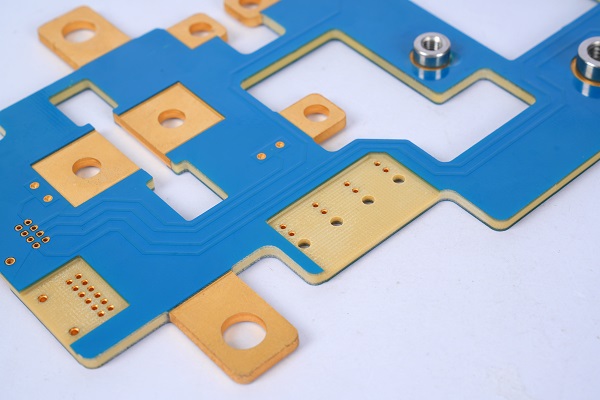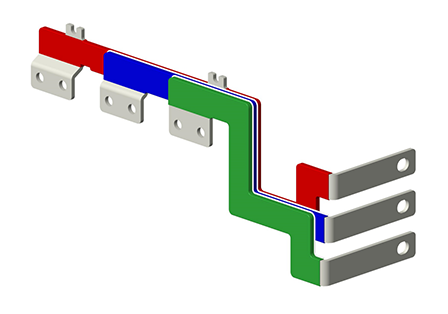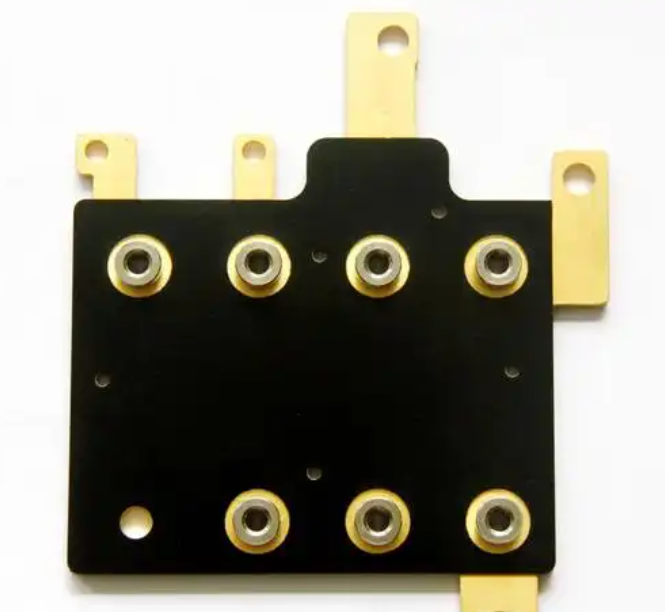The term embedded copper busbar PCB might sound complex at first, but it represents one of the most important innovations in modern power electronics. When electronic devices demand high current, stable heat dissipation, and long-term reliability, traditional PCBs reach their limits. Thatās where embedded copper technology steps in.
An embedded copper busbar PCB integrates solid copper blocks directly inside the boardās structure. These copper sections conduct heat and current far more efficiently than regular copper foil traces. The result? Enhanced thermal management, reduced voltage drop, and improved power density ā all within a compact design.
At Best Technology, we have spent years refining this technology, combining precise engineering with advanced lamination and drilling techniques. The goal is simple: help engineers design safer and more durable high-power PCBs for demanding industries such as automotive, renewable energy, power control, and aerospace.
What Is an Embedded Copper Busbar PCB?
An embedded copper busbar PCB is a circuit board that contains copper blocks inserted into specific regions of the substrate. These copper pieces act as built-in conductors, transferring both electrical current and heat more effectively than standard copper traces.
Unlike conventional designs that rely on thin copper layers, embedded copper PCBs use thick copper plates or bars, which can be several millimeters thick. These copper elements sit flush or slightly raised within the board structure, connecting directly to high-power components like MOSFETs, IGBTs, or power modules.
Essentially, the technology bridges the gap between traditional PCBs and metal busbars, combining the flexibility of PCB design with the strength of heavy copper.

How Does the Embedded Copper Process Work?
The manufacturing process involves embedding copper blocks into pre-cut slots within the PCB core. During lamination, the resin fills any tiny gaps between the copper and the surrounding substrate. Once cured, the copper becomes a permanent part of the board.
Hereās a simplified breakdown of the steps:
1. Slot Milling: Precise cavities are milled into the PCB core to hold the copper blocks.
2. Copper Block Preparation: Copper pieces are polished, cleaned, and sometimes wire-cut for small or complex shapes.
3. Brown Oxide Treatment: The copper surfaces undergo oxidation to improve adhesion.
4. Lamination: Layers are stacked with high-resin PP sheets, then pressed under heat and pressure to bond the copper inside.
5. Drilling & Plating: Holes are drilled, plated, and inspected to maintain alignment and connectivity.

The embedded copper is now part of the circuitās structure, providing a solid, thermally conductive path between components.
Fully Embedded vs. Semi-Embedded Copper Busbar PCBs
There are two main configurations of embedded copper busbar PCBs:
1. Fully Embedded Type
In this design, the copper block is completely enclosed within the PCB layers. The top and bottom surfaces are covered by laminate and copper foil. This structure provides excellent mechanical protection and a smooth board surface.
Key advantages include:
- Better insulation and electrical isolation.
- Flat surface ideal for multilayer integration.
- Enhanced durability for vibration-prone environments.

2. Semi-Embedded Type
In a semi-embedded design, part of the copper block is exposed or slightly protruding from the board surface. This configuration allows direct contact with high-heat components, such as power modules or metal housings, enhancing heat transfer.
Benefits include:
- Faster thermal conduction.
- Ideal for heat sinks or direct bonding applications.
- Reduced thermal resistance for high-current circuits.

Choosing between fully and semi-embedded structures depends on the applicationās power level, heat load, and assembly method.
Why Use Embedded Copper Busbar Technology?
Modern electronics are becoming smaller, more powerful, and more efficient ā and these trends increase the challenge of managing heat and current density. Embedded copper busbar PCBs are the solution to these challenges.
1. Superior Heat Dissipation
Copperās thermal conductivity is roughly 400 W/mĀ·K, which allows it to absorb and spread heat quickly. By placing copper blocks directly under hot components, the board dissipates heat faster, preventing hotspots and extending component lifespan.
2. Enhanced Current-Carrying Capacity
High-current devices such as inverters and converters often handle tens or hundreds of amps. Embedded copper blocks create a thicker and wider current path, minimizing resistance and voltage drop. This improves system efficiency and reliability.
3. Space-Saving Design
Instead of adding bulky external busbars, engineers can embed the copper directly inside the PCB. This approach reduces assembly complexity and makes the overall system more compact ā especially valuable for EV power modules and industrial drives.
4. Better Mechanical Stability
The embedded structure strengthens the PCB mechanically, reducing warpage and improving thermal shock resistance. This is essential for applications where temperature changes and vibration are frequent.
5. Simplified Assembly
With the busbar integrated into the PCB, component mounting becomes easier. It also eliminates additional soldering or mechanical fastening steps that external copper bars would require.
Applications of Embedded Copper Busbar PCBs
The use of embedded copper busbar technology has expanded rapidly across high-power industries. Here are some common examples:
- Electric Vehicles (EVs)
- Battery Management Systems
- DC-DC onverters
- Renewable Energy Systems
- Solar Inverters
- Wind Power Converters
- Industrial Power Supplies
- Aerospace and Defense
- Rail and Transportation Electronics
Each of these sectors values efficiency, thermal reliability, and mechanical strength ā qualities that embedded copper PCBs deliver consistently.
Design Considerations Engineers Should Know
Even though embedded copper technology is advanced, successful design still depends on key parameters:
- Copper Thickness: Ranges typically from 0.5mm to 3.0mm; thicker copper improves conductivity but affects stack-up balance.
- Slot and Block Size: Minimum recommended size is 3Ć3mm for stable lamination.
- Hole-to-Edge Distance: Keep at least 1.0mm to prevent delamination.
- Material Selection: Use FR-4 type PP or validated special materials with good resin flow. Avoid Rogers 4450F.
- Stack-Up Planning: Always use a core-to-core lamination structure to ensure strong adhesion and proper pressure distribution.
Designing a busbar PCB requires collaboration between electrical engineers, mechanical designers, and PCB fabricators. The early involvement of manufacturing experts helps optimize cost, yield, and performance.

How Embedded Copper Busbars Improve Thermal and Electrical Performance?
Letās consider a simple example. Imagine a power inverter that handles 80A continuous current. A standard 2oz copper PCB trace would require an extremely wide path to handle such current safely. Thatās impractical on compact boards.
By embedding a 2mm thick copper block, you can achieve the same current capacity within a fraction of the space, while also creating a thermal path directly beneath power semiconductors.
Tests show that boards using embedded copper busbars can reduce temperature rise by 30ā40Ā°C under identical load conditions compared to conventional designs. That directly translates into longer component life and improved efficiency.
Challenges and Considerations When Manufacture Busbar PCB
While the benefits are substantial, embedded copper PCB design requires precise process control. Factors like lamination pressure, resin flow, and alignment tolerance must be carefully monitored.
Manufacturers must also ensure:
- Flatness between copper and laminate surfaces.
- No voids or resin recession near copper edges.
- Reliable adhesion under high thermal cycling.
At Best Technology, we use core-to-core lamination, strict tolerance checks, and real-time MES traceability to manage every stage. Each board is verified for height uniformity, dielectric strength, and thermal reliability before delivery.
Why Choose Best Technology for Embedded Copper Busbar PCBs?
Best Technology specializes in advanced PCB fabrication for high-current and thermal-critical applications. Our embedded copper busbar PCBs are trusted by global clients in power control, automotive, and renewable energy sectors.
Hereās what sets us apart:
- Turnkey service from busbar PCB design, prototype, testing to mass production
- ISO9001, ISO13485, IATF16949, and AS9100D certificated
- Various PCB materials like FR-4, metal core, and ceramic-based boards.
- Mature busbar PCB manufacturing, whether you want fully-embedded type or semi-embedded.
- Every board goes through thermal shock testing, cross-section inspection, and IPC-6012 verification.
- Full traceability system ensures process consistency from material to shipment.
When you need a partner for complex busbar PCB design, our engineers support you from prototype to mass production with detailed feedback and optimized DFM solutions.
Conclusion
Embedded copper busbar PCBs represent a powerful evolution in PCB engineering ā where electrical performance meets thermal reliability. By integrating copper busbars within the PCB, designers achieve stronger, cooler, and more efficient systems without adding extra bulk.
For engineers working on EV power control, industrial automation, or renewable energy, this technology provides a solid foundation for long-term success.
If youāre planning to design a high-current embedded copper PCB, talk to Best Technology. Our professional team can help you select materials, define stack-up, and optimize the copper structure for your performance goals.


